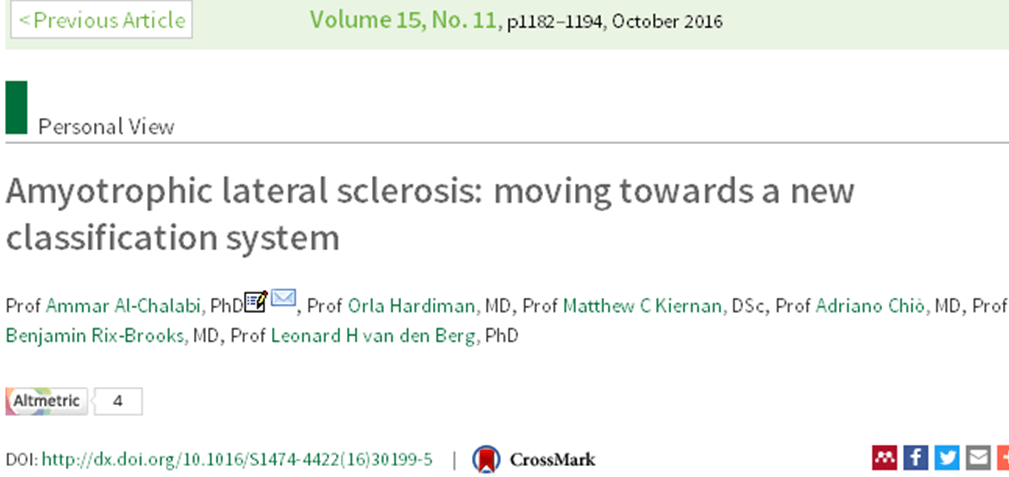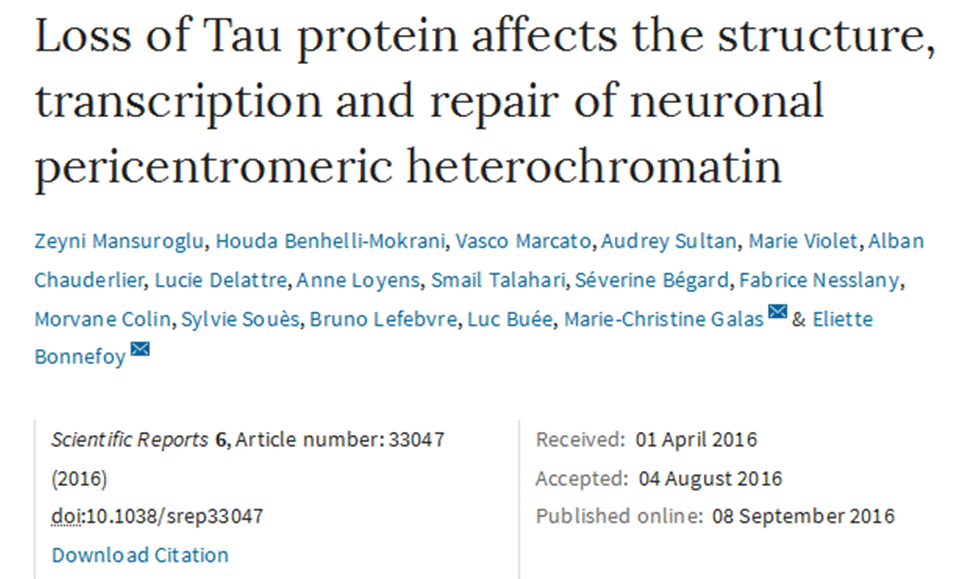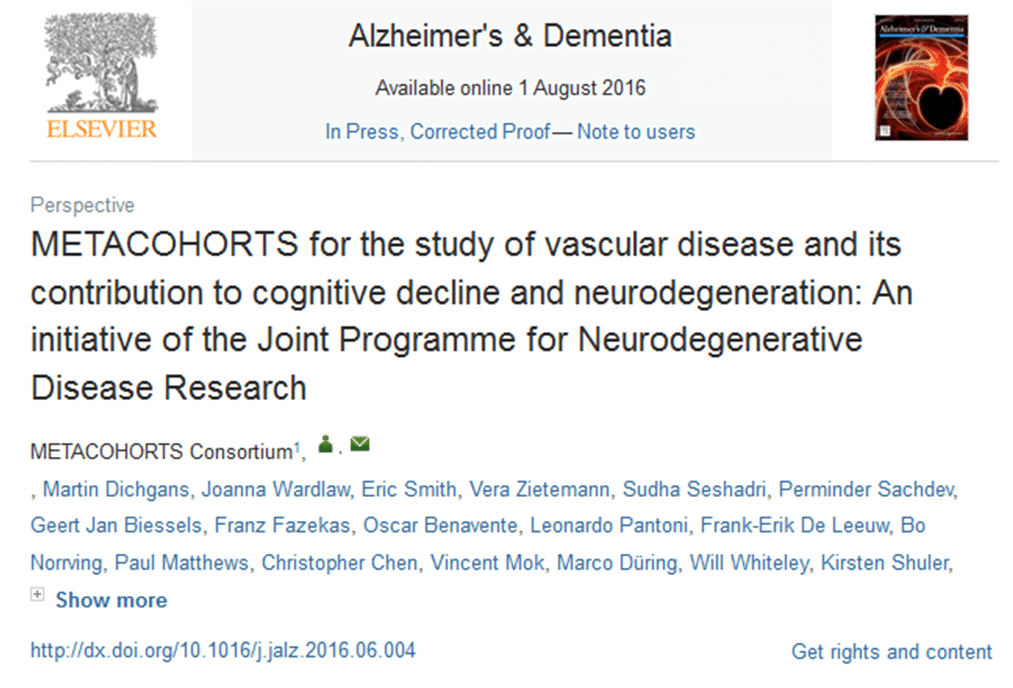 "Amyotrophic lateral sclerosis: moving towards a new classification system" has been published in The Lancet Neurology. This work was supported in part by JPND through the following projects: SOPHIA, selected for support under the 2011 biomarkers call, STRENGTH, selected for support under the 2012 risk factors call, and ALS-CarE, selected for support under the 2012 healthcare call.
"Amyotrophic lateral sclerosis: moving towards a new classification system" has been published in The Lancet Neurology. This work was supported in part by JPND through the following projects: SOPHIA, selected for support under the 2011 biomarkers call, STRENGTH, selected for support under the 2012 risk factors call, and ALS-CarE, selected for support under the 2012 healthcare call.
Yearly Archives: 2016
They’re two of the biggest mysteries in Parkinson’s disease research–where does the disease start? And how can it be stopped early in the process?
Now, a new laboratory model of Parkinson’s is giving scientists an inside look at what happens in the brain years before motor symptoms appear. Specifically, it demonstrates how abnormal alpha-synuclein proteins, which are strongly associated with Parkinson’s, gradually spread from an area of the brain implicated in the early stages of the disease to other regions of the brain ultimately damaged by the disease. The findings were published today in the Journal of Experimental Medicine.
Parkinson’s is primarily a disease of aging, with most cases diagnosed after age 60. By the time symptoms appear, more than half of the brain cells that produce dopamine, a chemical messenger needed for voluntary movement, have died. What triggers this process is unknown, although evidence points to a combination of genetic, epigenetic and environmental factors. Strong evidence also suggests that clumps of abnormal alpha-synuclein play a role in the disease process. In recent years, scientists have found links to the early stages of Parkinson’s in other areas of the body, namely the gut and the nose.
The study demonstrates that alpha-synuclein travels along nerve cells in the olfactory bulb–the part of the brain that controls sense of smell–prior to the onset of motor symptoms and that this area may be particularly susceptible to the spread of alpha-synuclein, ultimately causing deficits in the sense of smell. Clumps of alpha-synuclein eventually reach several additional brain regions, including the brainstem area that houses dopamine cells.
Paper: "Widespread transneuronal propagation of α-synucleinopathy triggered in olfactory bulb mimics prodromal Parkinson’s disease"
Reprinted from materials provided by the Van Andel Research Institute.
 "TDP‐43 loss of function inhibits endosomal trafficking and alters trophic signaling in neurons" has been published in The EMBO Journal. This research was supported in part by JPND through the PreFrontALS project, selected for support in the 2013 preventive strategies call.
"TDP‐43 loss of function inhibits endosomal trafficking and alters trophic signaling in neurons" has been published in The EMBO Journal. This research was supported in part by JPND through the PreFrontALS project, selected for support in the 2013 preventive strategies call.
For the first time, novel expression sites in the brain have been identified for a gene that is associated with Motor Neuron Disease and Frontotemporal Dementia.
Many people who develop Motor Neuron Disease, also called Amyotropic Lateral Sclerosis (ALS), and/or Frontotemporal Dementia (FTD) have abnormal repeats of nucleotides within a gene called C9orf72 which causes neurons to die.
A research team discovered that the C9orf72 gene is strongly expressed in the hippocampus of the mouse brain- a region where adult stem cells reside and which is known to be important for memory.
C9orf72 is also expressed at the olfactory bulb, involved in the sense of smell. Loss of smell is sometimes a symptom in FTD.
They also found that the C9orf72 protein changes from being concentrated in the cytoplasm of cells to both the cytoplasm and nucleus as the brain cortex develops, and during the development of neurons.
The researchers were working to map expression of C9orf72 in developing and adult mouse brains to help characterise reliable animal models to study the gene and its effects in both kinds of neurodegenerative diseases, for which there are currently no cures.
The exact function of C9orf72 in humans and animals remains unknown, but in the mutated version in patients there are large stretches of abnormal repeated sequences.
The study is published in the Journal of Anatomy.
The findings also confirmed previous research showing C9orf72 is strongly expressed in the cerebellum and motor cortex of the brain.
Paper: "Dynamic expression of the mouse orthologue of the human amyotropic lateral sclerosis associated gene C9orf72 during central nervous system development and neuronal differentiation"
Reprinted from materials provided by the University of Bath.
Using the landmark Framingham Heart Study to assess how physical activity affects the size of the brain and one’s risk for developing dementia, researchers have found an association between low physical activity and a higher risk for dementia in older individuals. This suggests that regular physical activity for older adults could lead to higher brain volumes and a reduced risk for developing dementia.
The researchers found that physical activity particularly affected the size of the hippocampus, which is the part of the brain controlling short-term memory. Also, the protective effect of regular physical activity against dementia was strongest in people age 75 and older.
Though some previous studies have found an inverse relationship between levels of physical activity and cognitive decline, dementia and Alzheimer’s disease, others have failed to find such an association. The Framingham study was begun in 1948 primarily as a way to trace factors and characteristics leading to cardiovascular disease, but also examining dementia and other physiological conditions. For this study, the researchers followed an older, community-based cohort from the Framingham study for more than a decade to examine the association between physical activity and the risk for incident dementia and subclinical brain MRI markers of dementia.
The researchers assessed the physical activity indices for both the original Framingham cohort and their offspring who were age 60 and older. They examined the association between physical activity and risk of any form of dementia (regardless of the cause) and Alzheimer’s disease for 3,700 participants from both cohorts who were cognitively intact. They also examined the association between physical activity and brain MRI in about 2,000 participants from the offspring cohort.
What this all means: one is never too old to exercise for brain health and to stave off the risk for developing dementia.
Paper: "Physical Activity, Brain Volume, and Dementia Risk: The Framingham Study"
Reprinted from materials provided by UCLA.
 "Loss of Tau protein affects the structure, transcription and repair of neuronal pericentromeric heterochromatin" has been published in Scientific Reports. This research was supported in part by JPND through the INSTALZ project, selected under the 2015 JPco-fuND call.
"Loss of Tau protein affects the structure, transcription and repair of neuronal pericentromeric heterochromatin" has been published in Scientific Reports. This research was supported in part by JPND through the INSTALZ project, selected under the 2015 JPco-fuND call.
New research has identified how cells protect themselves against ‘protein clumps’ known to be the cause of neurodegenerative diseases including Alzheimer’s, Parkinson’s and Huntington’s disease.
The study was done using a custom-built laboratory device that can compress neurons inside 3-D cell cultures while using a powerful microscope to continuously monitor changes in cell structure.
The study, published in Cell, offers an insight into the role of a gene called UBQLN2 and how it helps to remove toxic protein clumps from the body and protect it from disease.
Using biochemistry, cell biology and sophisticated mouse models, the researchers discovered that the main function of UBQLN2 is to help the cell to remove dangerous protein clumps – a role which it performs by first detangling clumps, then shredding them to prevent future tangles.
Protein clumps occur as part of the natural aging process, but are normally detangled and disposed of as a result of the gene UBQLN2. However when this gene mutates, or becomes faulty, it can no longer help the cell to remove these toxic protein clumps, which leads to neurodegenerative disease.
Previous work has shown that when the UBQLN2 gene is faulty, it leads to a neurodegenerative disease called Amyotrophic Lateral Sclerosis with Frontotemporal Dementia (ALS/FTD or motor-neuron disease with dementia). However until this study it was not fully understood why mutation of this gene caused disease.
Now that scientists understand exactly how UBQLN2 works and what it does, they are also able to understand why its mutation appears to be so detrimental to the body.
Indeed they hope that their findings will pave the way for new research into novel treatment options for patients with neurodegenerative diseases.
Source: University of Glasgow
Researchers have, for the first time, systematically recorded neural activity in the human striatum, a deep brain structure that plays a major role in cognitive and motor function. These two functions are compromised in Parkinson’s disease (PD), which makes the neuron-firing abnormalities the study results revealed key to better understanding the pathophysiology of PD and, ultimately, developing better treatments and preventions. The study findings are reported in the current online issue of the Proceedings of the National Academy of Sciences.
In this study, the researchers compared striatal recordings across people who have PD and other neurological disorders (dystonia and essential tremor) with correlative findings in nonhuman primates. The researchers undertook a rigorous, several-year selection process to find the right patients undergoing surgical deep brain stimulation treatment in order to obtain sufficient recordings. The study was further supported by the researchers comparing data obtained in nonhuman primates, which provided critical animal controls and disease models.
The researchers’ next steps are to continue investigating the physiological and molecular mechanisms participating in the abnormal firing of striatal projection neurons in PD. Understanding these mechanisms is key to developing target-specific treatments to improve the lives of people who have PD.
Paper: "Human striatal recordings reveal abnormal discharge of projection neurons in Parkinson’s disease"
Reprinted from materials provided by Emory Health Sciences.
Researchers have discovered a gene signature in healthy brains that echoes the pattern in which Alzheimer’s disease spreads through the brain much later in life. The findings, published in the journal Science Advances, could help uncover the molecular origins of this devastating disease, and may be used to develop preventative treatments for at-risk individuals to be taken well before symptoms appear.
The results identified a specific signature of a group of genes in the regions of the brain which are most vulnerable to Alzheimer’s disease. They found that these parts of the brain are vulnerable because the body’s defence mechanisms against the proteins partly responsible for Alzheimer’s disease are weaker in these areas.
The results imply that healthy young individuals with an aberrant form of this specific gene signature may be more likely to develop Alzheimer’s disease in later life, and would most benefit from preventative treatments, if and when they are developed for human use.
Alzheimer’s disease, the most common form of dementia, is characterised by the progressive degeneration of the brain. Not only is the disease currently incurable, but its molecular origins are still unknown. Degeneration in Alzheimer’s disease follows a characteristic pattern: starting from the entorhinal region and spreading out to all neocortical areas. What researchers have long wondered is why certain parts of the brain are more vulnerable to Alzheimer’s disease than others.
One of the hallmarks of Alzheimer’s disease is the build-up of protein deposits, known as plaques and tangles, in the brains of affected individuals. These deposits, which accumulate when naturally-occurring proteins in the body fold into the wrong shape and stick together, are formed primarily of two proteins: amyloid-beta and tau.
The researchers found that part of the answer lay within the mechanism of control of amyloid-beta and tau. Through the analysis of more than 500 samples of healthy brain tissues from the Allen Brain Atlas, they identified a signature of a group of genes in healthy brains. When compared with tissue from Alzheimer’s patients, the researchers found that this same pattern is repeated in the way the disease spreads in the brain.
Our body has a number of effective defence mechanisms that protect it against protein aggregation, but as we age, these defences get weaker, which is why Alzheimer’s generally occurs in later life. As these defence mechanisms, collectively known as protein homeostasis systems, get progressively impaired with age, proteins are able to form more and more aggregates, starting from the tissues where protein homeostasis is not so strong in the first place.
Earlier this year, the same researchers behind the current study proposed that ‘neurostatins’ could be taken by healthy individuals in order to slow or stop the progression of Alzheimer’s disease, in a similar way to how statins are taken to prevent heart disease. The current results suggest a way to exploit the gene signature to identify those individuals most at risk and who would most benefit from taking neurostatins in earlier life.
Although a neurostatin for human use is still quite some time away, a shorter-term benefit of these results may be the development of more effective animal models for the study of Alzheimer’s disease. Since the molecular origins of the disease have been unknown to date, it has been difficult to breed genetically modified mice or other animals that repeat the full pathology of Alzheimer’s disease, which is the most common way for scientists to understand this or any disease in order to develop new treatments.
Paper: "A protein homeostasis signature in healthy brains recapitulates tissue vulnerability to Alzheimer’s disease"
Reprinted from materials provided by the University of Cambridge.
 The JPND working group on vascular contributions to neurodegeneration, which was selected under the 2014 call for working groups on cohort studies, brought together 55 international experts on brain disease and dementia to survey the data from more than 90 studies, representing more than 660,000 participants.
The JPND working group on vascular contributions to neurodegeneration, which was selected under the 2014 call for working groups on cohort studies, brought together 55 international experts on brain disease and dementia to survey the data from more than 90 studies, representing more than 660,000 participants.
The working group's final results and recommendations were recently published in the journal Alzheimer's & Dementia. To access the full paper, "METACOHORTS for the study of vascular disease and its contribution to cognitive decline and neurodegeneration," click here.
